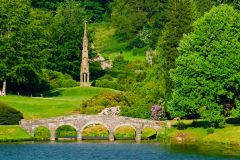Organic products
Organic gardening hasn't changed much from the way our grandfathers gardened years ago, in some respects. They relied on manure or garden compost to improve the soil, and on fertilizers, such as hoof and horn, or bonemeal, based on animal remains. Strong plants growing in healthy soil have a natural ability to withstand minor problems, but, if needed, our forbears used natural products, like soft soap, pyrethrum, or derris, to tackle most common pests, and sulphur and copper compounds, such as Bordeaux mixture, to treat fungal diseases.
These products and their modern alternatives (which are often specific in their action and less persistent in the environment) are now widely available in garden centres, although since the BSE crisis, many people prefer not to use animal-based fertilizers. Poultry-manure pellets are a good alternative, but 'vegetarian' general-purpose feeds are available from specialist suppliers. Nowadays, a huge selection of organic supplies is available through mail order catalogues, even if your local garden centre doesn't stock them.
Me? I've settled on a system that allows a steady build-up of natural predators and which makes sure that there is no concentration of any one plant in any one place, so epidemics are less likely. I never spray with pesticides — organic or inorganic — and I have learned to live with the odd nibbled leaf and blemished apple. A garden that teems with all forms of wildlife seems to me preferable to one that is perfect but sterile.
Making your own plant food
If you like to do-it-yourself, you can make your own liquid feed by dunking a sack of manure into a water tank for a few weeks. Draw off the 'manure tea' and dilute to about 1:5 with water; use it on your vegetable patch, or for anything around the garden in need of a quick boost. There's an even 'greener' alternative. Fill a tub with nettles or comfrey leaves, top it up with water and cover it with a lid, and a few weeks later you have a (rather smelly) brew ready to use. Dilute it in the same way as manure tea. The nettle version makes a high-nitrogen liquid feed that is good for vegetables and salads, while the comfrey 'flavor' is a high-potash feed that's especially good for tomatoes.
You can visit this flower guide for more information about this article.

